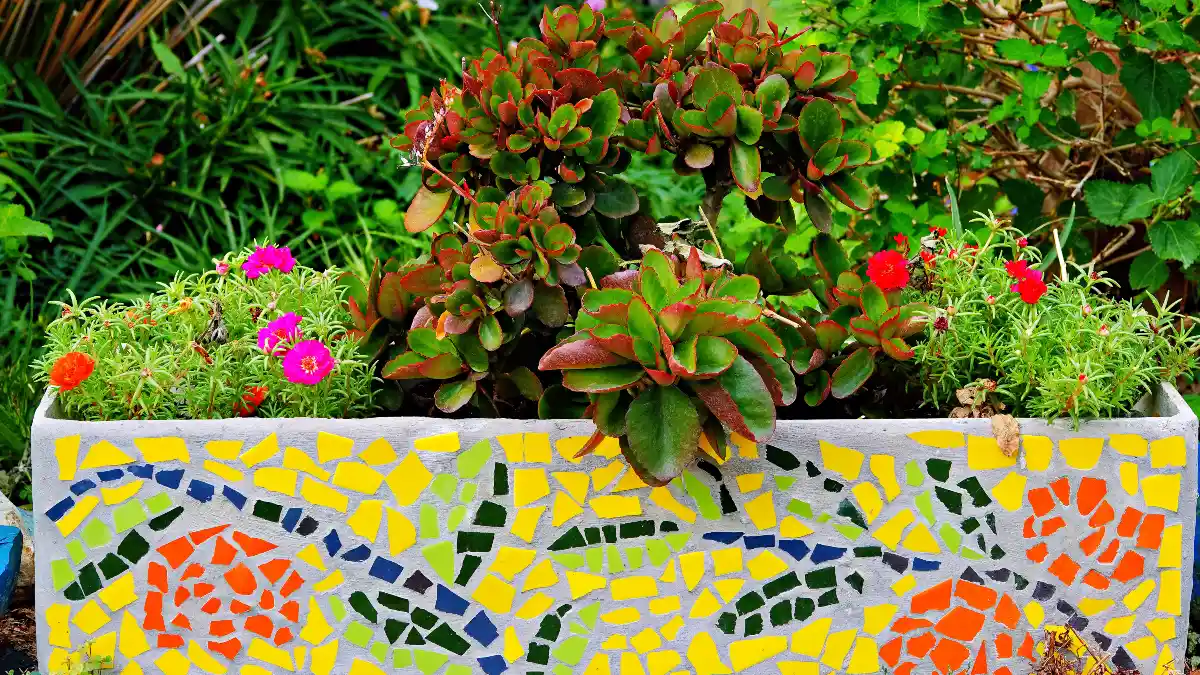Want color that never fades and patterns that survive winters? Garden mosaics turn plain paths and pots into art—if you build them to last. Most outdoor fails aren’t about talent; they’re about the wrong tile, glue, grout, or base. Freeze–thaw pops pieces off porous substrates, pooled water creeps under tiles, and rigid surfaces without movement joints crack.
The fix is straightforward: choose frost-proof tiles (porcelain with ≤0.5% water absorption), set them with a high-performance A118.15 thin-set, and grout with epoxy so stains, water and winter can’t get in. Add a 2% slope (¼″ per foot) so water drains, target ≥95% mortar coverage outdoors, and understand slip guidance (ANSI A326.3) so footpaths are safe in the wet.
You’ll learn exactly how to do that—plus 15 garden mosaic ideas, from stepping stones to vertical murals, and a detailed DIY mosaic stepping stones walkthrough that respects TCNA/ANSI methods and leading brand manuals (Daltile, CUSTOM Building Products).
Expect precise specs, not guesswork: slope, coverage, expansion joints, adhesive/grout callouts, and product categories you can ask for at any tile counter. This is your blueprint to a durable mosaic garden path and other outdoor mosaic tiles projects that look great for years, not months.
Best Outdoor Materials
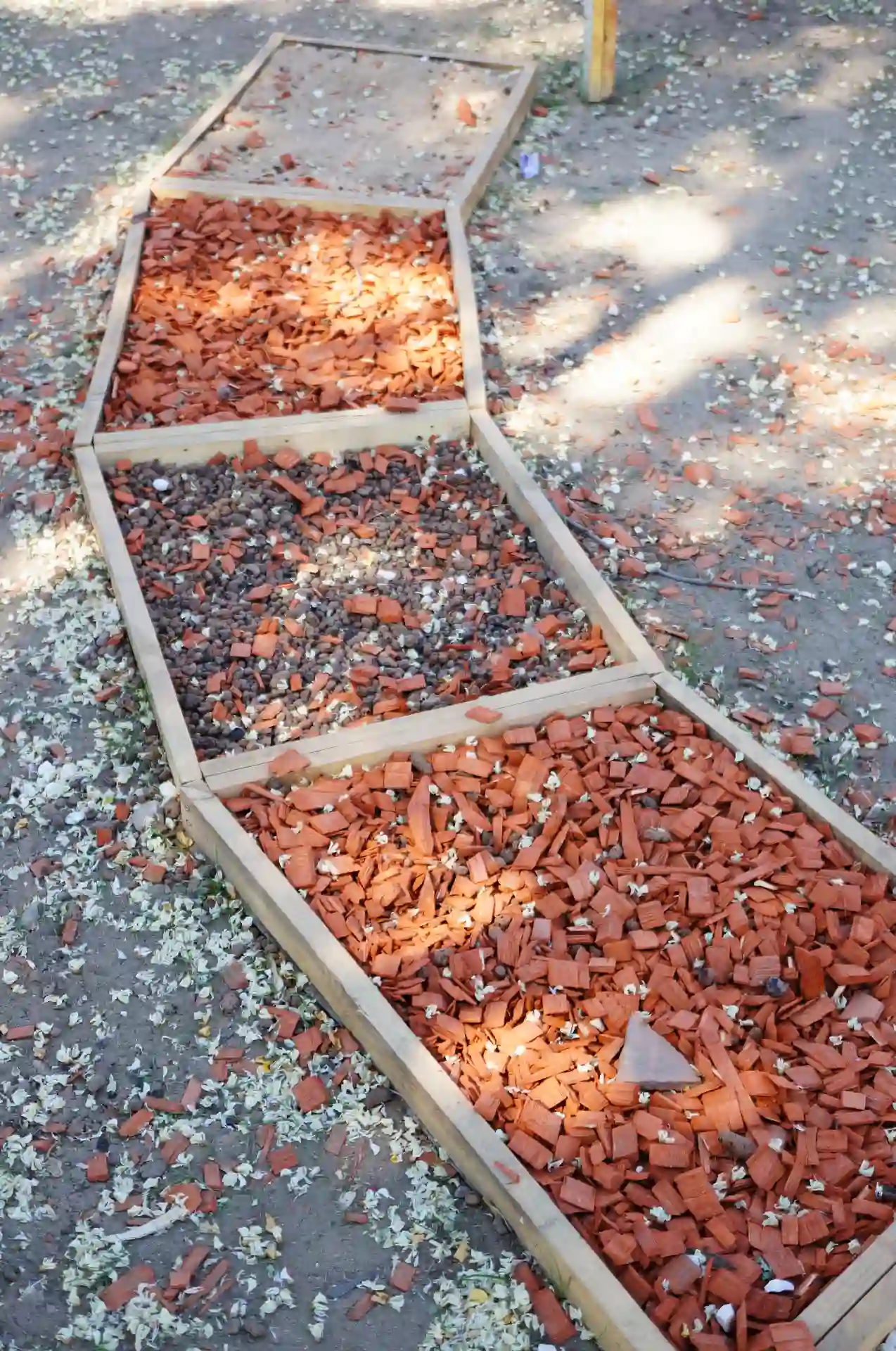
Build-Ready Materials Guide (2025)
Actionable extras for choosing tiles, adhesives, grout & slip safety—beyond the section text.
Quick Decision: Freeze-Climate Ready
Use this to pick a fail-safe material stack in under a minute.
- Does your garden freeze? If yes, use porcelain (impervious ≤0.5% absorption) or exterior-rated glass.
- Setting material: choose a polymer-modified thinset meeting ANSI A118.15. For tricky substrates or severe freeze–thaw, follow the substrate maker’s instructions—some assemblies specify epoxy setting.
- Grout: prefer epoxy grout (ANSI A118.3)—non-porous, color-true, and no sealer needed.
- Slip safety: finishes listed by the manufacturer for exterior wet; treat DCOF (ANSI A326.3) as a comparison tool—pair texture with drainage and cleaning.
Tile Absorption Classes (ANSI A137.1)
| Class | Water Absorption | Outdoor Note |
|---|---|---|
| Impervious (Porcelain) | ≤ 0.5% | Best for freeze–thaw |
| Vitreous | > 0.5% – 3% | Use with caution; check manufacturer’s exterior rating |
| Semi-vitreous | 3% – 7% | Generally avoid outdoors |
| Non-vitreous | > 7% | Not suitable for exterior exposure |
Tip: Look for “ASTM C373 < 0.5%” on porcelain data sheets.
Slip in the Real World (Beyond DCOF)
Reminder from manufacturers & TCNA: DCOF numbers are comparative; texture, drainage and maintenance are decisive.
Adhesive & Grout: What to Choose When
| Category | Use | Why | Notes |
|---|---|---|---|
| Thinset A118.4 | Basic interiors | Polymer-modified but mid-grade | Not the go-to for challenging exterior work |
| Thinset A118.15 | Exterior default | Higher performance & deformability | Great with porcelain & large/heavy tiles |
| Epoxy setting | Special substrates / severe freeze–thaw | Exceptional bond & chemical resistance | Use only if assembly calls for it |
| Epoxy grout A118.3 | Exterior & wet areas | Non-porous, color-true, no sealer | Follow exact mix & wash timings |
Brand examples: LATICRETE SPECTRALOCK® (grout), MAPEI Kerapoxy CQ (grout). For mortars, look for “meets ANSI A118.15”.
Field-Tested Spec to Copy
- Tile: Porcelain labeled “Impervious / ASTM C373 ≤0.5%” or exterior-rated glass.
- Adhesive: Polymer-modified thinset ANSI A118.15; follow pot life and open time.
- Grout: Epoxy (ANSI A118.3); no sealing required.
- Safety: Finish listed for exterior wet; pair with ~2% slope and regular cleaning.
Expert reminders: “Movement joints aren’t optional outdoors” — Tile Council of North America (EJ171). “Epoxy grout retains color and resists stains in exterior exposure” — LATICRETE technical literature.
Common Fail Points to Skip
- Regular mirror pieces: backing can de-silver (“black rot”) with cement mortars. Use mirror-safe adhesives—or avoid outdoors.
- High-absorption bases: solid terracotta or wood in freeze climates. Prefer concrete, stone, or foam-cored cement boards (e.g., Wedi/Jackoboard).
- Mastic indoors-only: premixed mastics aren’t for exterior mosaics—use thinset A118.15.
- Ignoring data sheets: exterior success lives in the fine print (mix ratios, cure, and wash timings).
Tiles (exterior-rated only). For paths, steps, tabletops and plinths, default to porcelain or exterior-rated glass. In the U.S. definition (ANSI A137.1), porcelain means ≤0.5% water absorption—the threshold that correlates with frost resistance. Look for the spec on the product sheet (often “ASTM C373 < 0.5%”) and an exterior/wet suitability note. That “impervious” rating is what lets mosaics ride out freeze–thaw without spalling.
Slip underfoot (A326.3, but think beyond the number). On walkable surfaces, choose textures and finishes recommended for exterior wet. ANSI A326.3 gives wet DCOF categories and typical minimums (~0.42–0.55 depending on area), but the standard itself and major manufacturers stress DCOF is for comparison—not a guarantee of safety. You still need texture, drainage and maintenance.
Adhesive (the right thin-set). Outdoors, specify a polymer-modified thin-set that meets ANSI A118.15. It’s the high-performance class (higher bond, deformability, options for fast-set/large-and-heavy tile) and a safer bet than basic A118.4 in demanding conditions. In severe freeze–thaw or special substrates, some assemblies use epoxy setting—follow the substrate and manufacturer instructions.
Grout (epoxy = long-term durability). If you only upgrade one thing, make it grout. Epoxy grout (e.g., LATICRETE SPECTRALOCK or MAPEI Kerapoxy CQ) meets ANSI A118.3, is non-porous, never needs sealing, cleans back to original color, and shrugs off freeze, stains and birdbaths. That’s why it’s the standard exterior recommendation for high exposure.
What to avoid (common failure points).
• Regular mirrors will “black-rot” (de-silver) when cementitious materials or the wrong adhesives contact the backing—use mirror-safe mastics/epoxies or avoid mirror outdoors.
• Terracotta and wood bases are unreliable in freeze zones; they absorb water and degrade. Use concrete, porcelain-clad concrete, stone, or foam-cored cement boards (Wedi/Jackoboard) instead.
Plan the Base: Slope, Coverage & Movement Joints
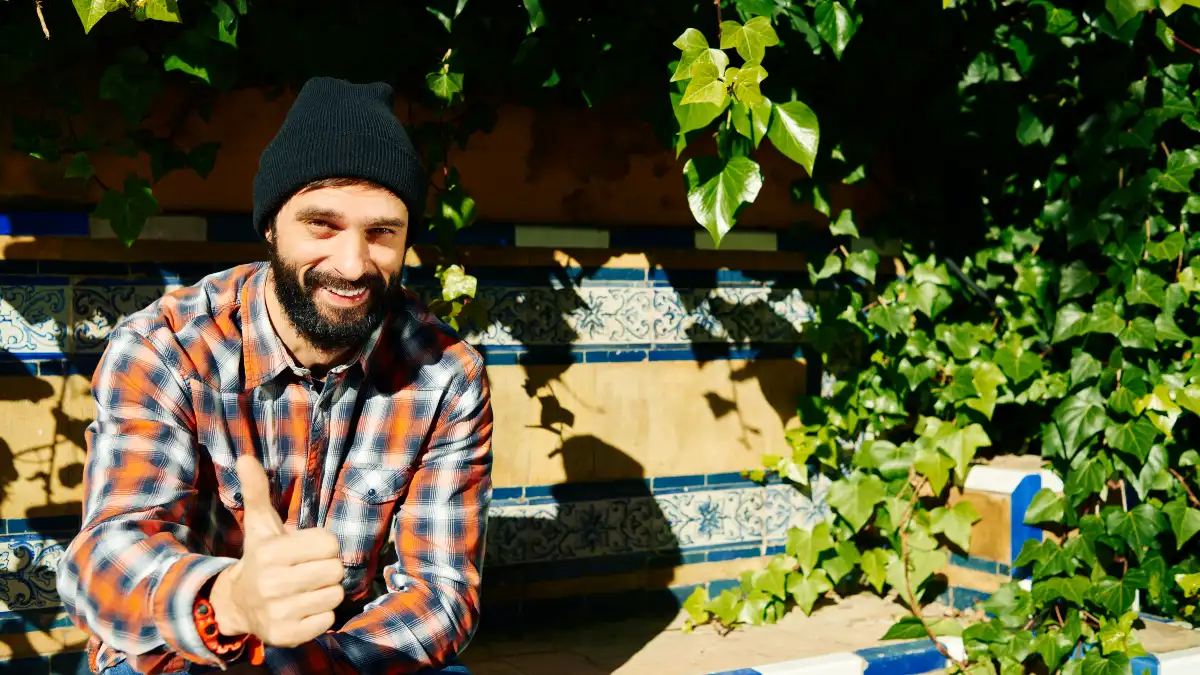
Slope (drain water at 2%). Any horizontal exterior surface should be built with ¼″ per foot (≈2%) slope to a drain or edge so water doesn’t pond. This aligns with tile and deck guidance from major manufacturers; when you see “positive drainage,” think no standing water after rain under normal drying conditions.
Coverage (≥95% outdoors). Your bond must be nearly full to keep water from pooling in voids. ANSI A108/TCNA guidance calls for ≥95% thin-set coverage in exterior and wet locations, with no voids larger than ~2 in² and full support at edges and corners. Back-butter large/irregular pieces and key mortar into both surfaces to hit the number.
Movement joints (EJ171). All tile moves with temperature and moisture. TCNA EJ171 provides the roadmap: on exterior work, provide field joints roughly every 8–12 ft each direction, plus at perimeters and changes of plane. Typical minimum widths are ⅜″ at 8′ bays and ½″ at 12′ bays—and go wider in intense sun or with dark surfaces.
Membranes & profiles (what they do—and don’t). Waterproofing and uncoupling do not eliminate the need for movement joints. Use movement-profile trims where continuous soft joints are hard to detail (e.g., long runs across a patio).
Garden Mosaic Ideas You Can Build

Choose one and finish in a day or weekend. Each idea assumes porcelain or exterior-rated glass, A118.15 thin-set, and epoxy grout unless noted.
DIY mosaic stepping stones (paver + thin-set + epoxy). Set tesserae on a concrete paver, ⅛–3⁄16″ joints, grout with epoxy. Solid beginner path to master coverage and clean-up.
Compass-rose path medallion. Use textured porcelain pieces for grip and maintain the area’s ¼″/ft slope. Pop it into a patio on its own mortar bed with soft joints around.
Birdbath rim or bowl liner. Small glass or porcelain tesserae, epoxy grout only (it’s non-porous and doesn’t need sealer). Avoid solvent-based sealers in water bowls.
Planter or low-wall banding. Wrap a concrete planter or masonry plinth; avoid terracotta in freeze climates.
Garden tabletop (on a concrete or stone top). Porcelain mosaic on a sloped or drip-edged top; leave a perimeter movement joint or use movement-profile trim. (EJ171 concept.)
Bench seat inlays. Use small porcelain mosaics in zones (seat/front/side), separated by soft joints to manage thermal movement. (EJ171.)
Vertical mosaic mural (Wedi/Jackoboard). Foam-cored cement boards (Wedi/Jackoboard) are light, weather-tolerant, easy to hang—great for a fence panel or shed wall.
Pebble or stone mosaic pavers. Bed natural pebbles in mortar over a compact base; keep 2% slope and soft joints between panels.
Stair riser bands. Non-slip mosaic bands on risers only (not treads); maintain DCOF on treads via textured porcelain. (A326.3 guidance.)
Fountain surround (not submerged). Porcelain/glass at splash zone; epoxy grout; bond breaker and movement joints at plane changes. (EJ171 principles.)
Mailbox plinth wrap. Wrap a masonry pier with mosaic, include perimeter soft joints; avoid wood posts unless fully isolated.
Raised-bed cap accent. Add a porcelain mosaic band to concrete caps; keep expansion gaps at sections.
Stepping-stone series with insets. Cast or set a series of 12–16″ stones with recurring colors; set them flush with soil and on a compacted bed for safe footing. (General path safety & slip logic.)
Potting table backsplash. Exterior-rated glass on a cement board panel; epoxy grout resists staining from soil/compost.
Upcycled “trencadís” focal boulder. Use frost-proof dishes/tiles only; avoid unknown vintage glazes that might be soft/lead-bearing; epoxy grout to lock out water. (Definition & safety context.)
Step-by-Step: A Durable Stepping Stone (1–2 hours + cure)
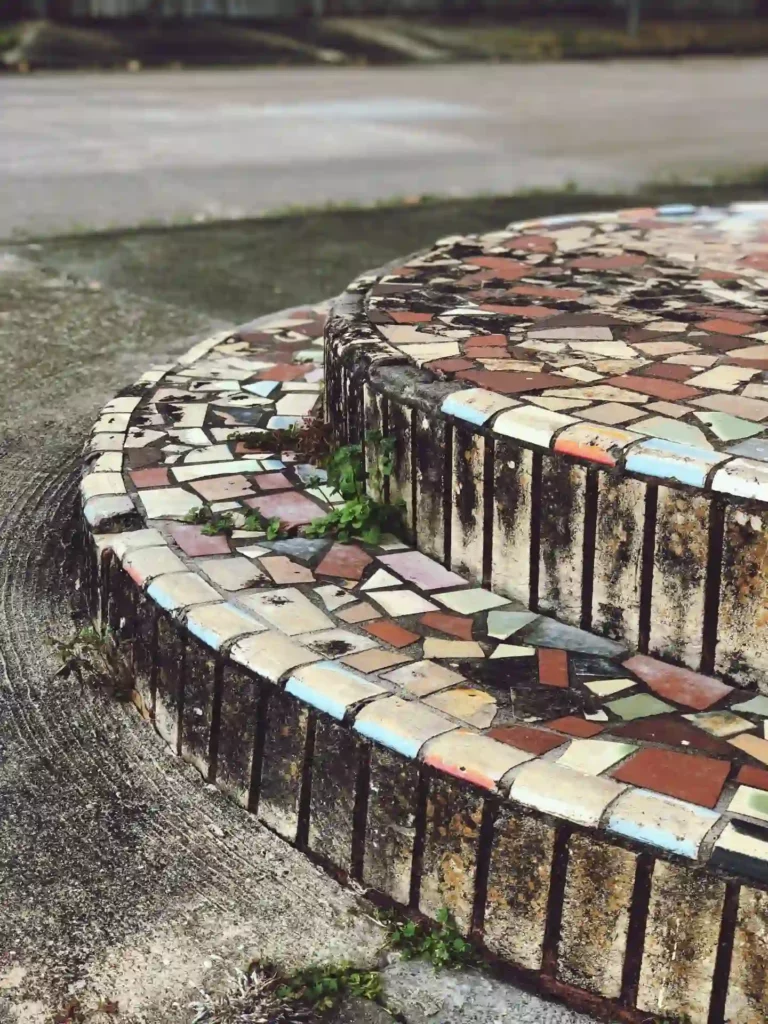
What you’re making: pro-grade DIY mosaic stepping stones that hold up outdoors. Use outdoor mosaic tiles (porcelain or glass), a polymer-modified thinset meeting ANSI A118.15, and epoxy grout (ANSI A118.3).
1) Prep the base (10 min).
- Pick a dense concrete paver/stone, 1½–2″ thick. Scrub off dust, laitance, or release with a stiff brush; rinse and let surface dry damp—not dripping. Lightly scuff smooth faces for bite.
- Dry-lay your tesserae to confirm layout and joint width (target ⅛–3⁄16″).
2) Mix & spread the adhesive (15–20 min).
- In a bucket, mix an ANSI A118.15 thinset to a creamy, ridge-holding consistency (follow bag ratios). “Burn-in” a tight skim coat with the flat side of a trowel to key mortar into the paver, then immediately comb fresh ridges with a ¼″ square-notch. Press each tessera in with a slight twist; lift a piece occasionally to verify transfer. Aim for ~95% contact with no voids under edges.
3) Set the pieces (20–30 min).
- Keep joints even (⅛–3⁄16″). Maintain a flush surface free of sharp edges. Clean squeeze-out as you go. For glass, seat flush so epoxy can cap and protect edges.
- Let thinset firm up per datasheet (often 2–4 hours before light handling; full cure longer—check label).
4) Grout for weather (25–35 min + cure).
- Mix epoxy grout (e.g., SPECTRALOCK® PRO Premium or MAPEI Kerapoxy CQ) exactly per parts A/B/C. Pack joints fully; wash in two stages with manufacturer’s wash packets or neutral cleaner to return the tile to original color. Epoxy needs no sealer and is highly stain/weather resistant. Protect from traffic until initial cure; maximum stain resistance develops after full cure (often 7 days at ~21 °C).
5) Place stones for safety & drainage (10–15 min).
- Bed stones on compacted gravel/sand so each sheds water at ~¼″ per foot (2%)—no puddles—and sits flush with surrounding grade (no “trip lips”). Choose tiles/textures appropriate for exterior-wet use and mind DCOF/A326.3 guidance; texture and drainage matter as much as a number.
Learn by watching: Search YouTube for “How I Mosaic a Stepping Stone” (clear, start-to-finish walkthrough).
Design That Pops: Color, Pattern & 2025 Trends
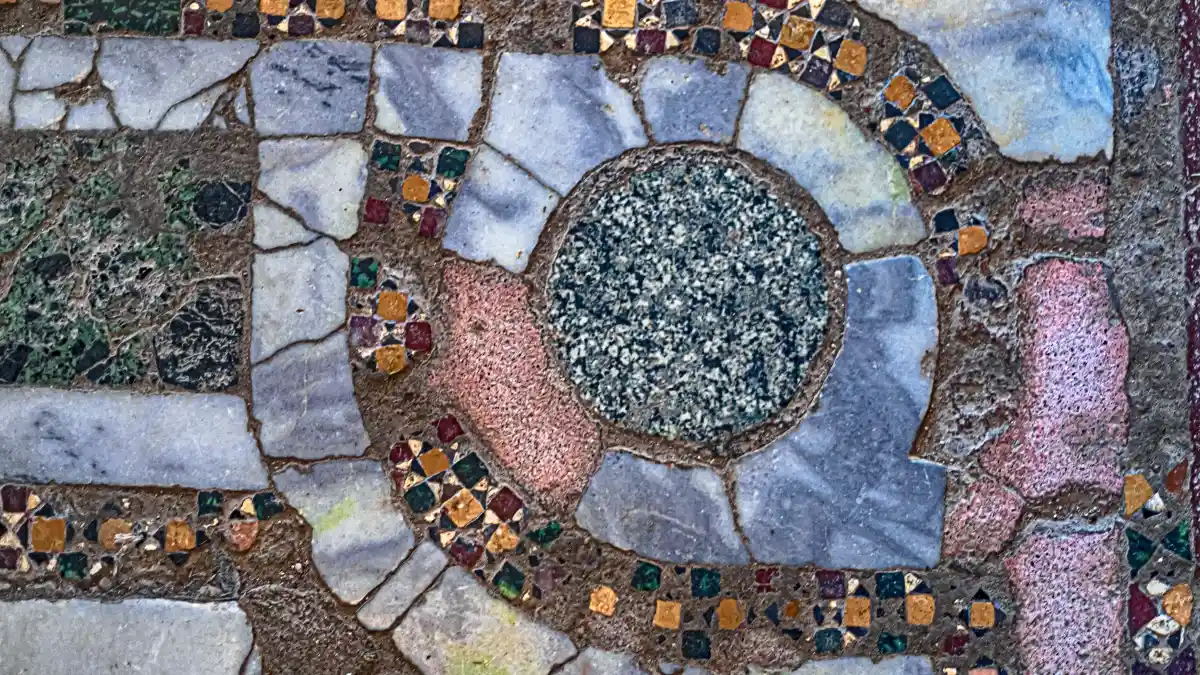
Checkerboards & bold contrast. Checkerboard and bordered layouts have cycled from “trend” to timeless graphic—they read strongly even in small inserts or medallions along a mosaic garden path. 2025 roundups note checkerboard’s return as a go-to pattern language across floors and hardscapes. Use high-contrast porcelain (matte/structured) in two tones, or flip to soft pastels for a preppy, garden-party vibe.
Sustainability & upcycling front-and-center. Major shows like RHS Chelsea embedded sustainability into entries (materials reuse, relocation plans, lower-carbon hardscape choices). Bring that home by incorporating recycled glass tesserae, reclaimed pavers, or “use-what-you-have” borders.
Story-driven mosaics & mixed scale. 2025 pro/brand reports call out mosaics that tell a story—mixing scales (macro motifs + micro background), blending gloss/matte, and combining stone with glass for depth. Use one “hero” motif (leaf, compass, bird) framed by smaller field tesserae for hierarchy and legibility from a path.
Trencadís, the joyful wildcard. Broken-tile trencadís (pique assiette) yields organic, lively surfaces—great for planter bands and accent risers. Keep it garden-tough by sticking to frost-proof porcelain or vetted glass and an epoxy grout.
Grouting, Sealing & Safety Outdoors

Pick grout for the weather. For exterior, wet, and muddy boots, epoxy grout (ANSI A118.3) is the durability champ: highly stain-resistant, color-true, and doesn’t require sealing. Confirm workable time/windows and follow the manufacturer’s wash sequence to avoid haze. Examples: LATICRETE SPECTRALOCK® PRO Premium and MAPEI Kerapoxy CQ.
If you do seal, choose wisely. Epoxy joints need no sealer; but if your tile (not grout) needs protection or you used cement grout in a non-submerged area, use a penetrating, exterior-rated, vapor-permeable sealer per the tile maker’s guidance. Avoid harsh solvent cleaners that can degrade sealers; stick to pH-neutral maintenance products specified by the grout/sealer brand.
Lead safety when upcycling crockery. Vintage/handmade ceramics can leach lead, especially with acidic rainwater or birdbaths. If you can’t verify the glaze, don’t use it in food/water-contact zones; prefer newly manufactured, food-safe ware or frost-proof porcelain. The U.S. FDA documents lead risks in traditional pottery and advises testing or avoiding unknown items in food/water contact.
Mirror bits outside? Only if you use mirror-safe adhesives; otherwise the silvering oxidizes and turns black (“black rot”). For longevity, many pros skip mirror outdoors altogether or confine it to covered, vertical locations.
Slip & safety. For walkable mosaics, use products the manufacturer lists for exterior/wet and check ANSI A326.3 DCOF specs. Remember: DCOF is comparative, not a slip guarantee—texture and drainage/slope (≈¼″ per ft) are critical. Add anti-slip treatments on smooth porcelain if needed.
Care & Longevity: What to Do Each Season
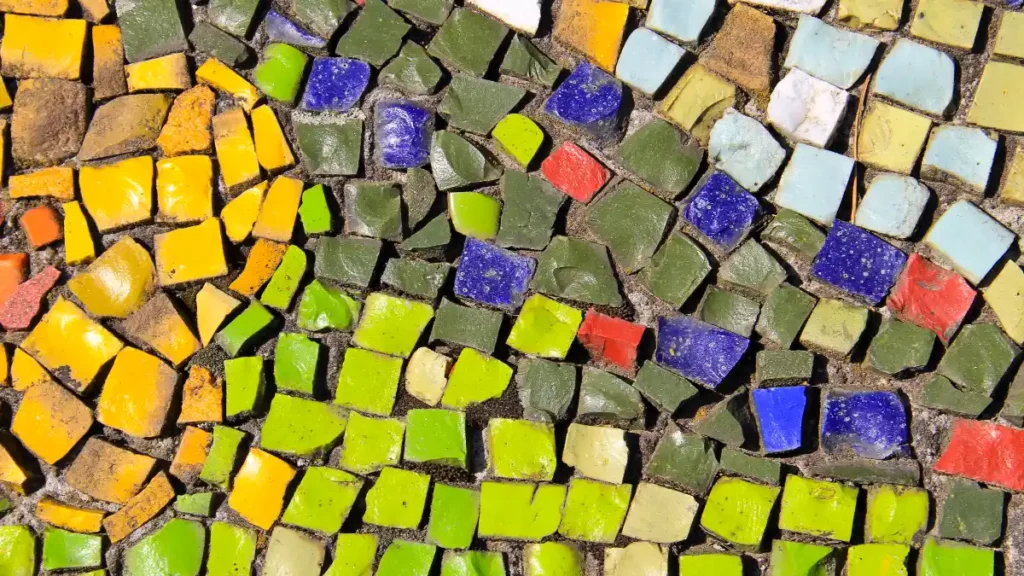
Spring (inspect & flex). Walk your mosaic garden path after thaws. Look for cracked edges, popped tesserae, or split perimeter caulk. Replace/restore movement joints where needed (soft sealant over backer rod), following EJ171 principles for exterior assemblies.
Summer (clean smart). Wash surfaces with pH-neutral cleaners approved by your grout/tile brand; rinse well. Skip bleach/harsh acids that can damage grout or degrade sealers. Spot-treat epoxy haze or greasy soils with brand-specific cleaners.
Autumn (drainage tune-up). Sweep joints, re-sand bedding around stepping stones, and confirm the ¼″-per-foot slope still sheds water—no ponding before freezes. Touch up anti-slip treatments on smooth pieces where traffic warrants.
Winter (be gentle). Brush snow with plastic tools; avoid metal edges that can chip tiles. If you must de-ice, understand that while porcelain generally tolerates salts, cementitious grout can show efflorescence and nearby plants can suffer—use sand for traction and rinse residues later.
Conclusion
The longest-lasting garden mosaics follow a simple, proven recipe: frost-rated porcelain or exterior glass, set with ANSI A118.15 thinset (or an epoxy setting system where specified), over a base pitched ¼″ per foot (≈2%) so water never lingers. Aim for ≥95% mortar coverage to block voids, and cut EJ171-style movement joints into the work (field, perimeter, and changes of plane) so thermal swings don’t crack your art. This is the same best-practice pattern you’ll see echoed in TileLetter’s EJ171 guidance, Lowe’s pro category explanations for mortars and grouts, and CUSTOM Building Products exterior installation manuals.

